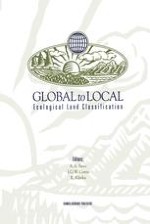1996 | OriginalPaper | Chapter
A National Framework for Monitoring and Reporting on Environmental Sustainability in Canada
Authors : Ian B. Marshall, C. A. Scott Smith, Corrine J. Selby
Published in: Global to Local: Ecological Land Classification
Publisher: Springer Netherlands
Included in: Professional Book Archive
Activate our intelligent search to find suitable subject content or patents.
Select sections of text to find matching patents with Artificial Intelligence. powered by
Select sections of text to find additional relevant content using AI-assisted search. powered by
In 1991, a collaborative project to revise the terrestrial component of a national ecological framework was undertaken with a wide range of stakeholders. This spatial framework consists of multiple, nested levels of ecological generalization with linkages to existing federal and provincial scientific databases. The broadest level of generalization is the ecozone. Macroclimate, major vegetation types and subcontinental scale physiographic formations constitute the definitive components of these major ecosystems. Ecozones are subdivided into approximately 200 ecoregions which are based on properties like regional physiography, surficial geology, climate, vegetation, soil, water and fauna. The ecozone and ecoregion levels of the framework have been depicted on a national map coverage at 1:7 500 000 scale. Ecoregions have been subdivided into ecodistricts based primarily on landform, parent material, topography, soils, waterbodies and vegetation at a scale (1:2 000 000) useful for environmental resource management, monitoring and modelling activities. Nested within the ecodistricts are the polygons that make up the Soil Landscapes of Canada series of 1:1 000 000 scale soil maps. The framework is supported by an ARC-INFO GIS at Agriculture Canada. The data model allows linkage to associated databases on climate, land use and socio-economic attributes.
